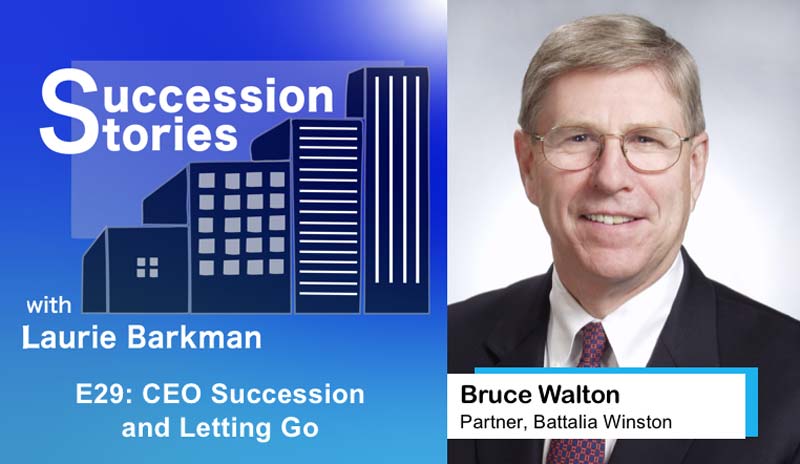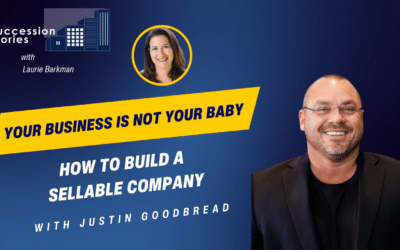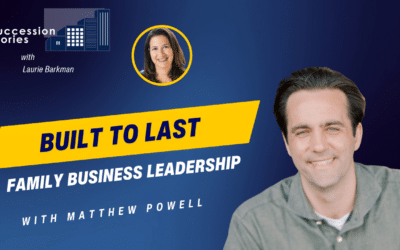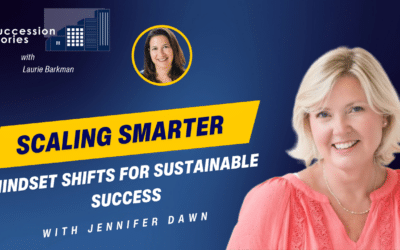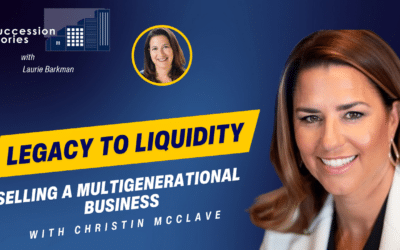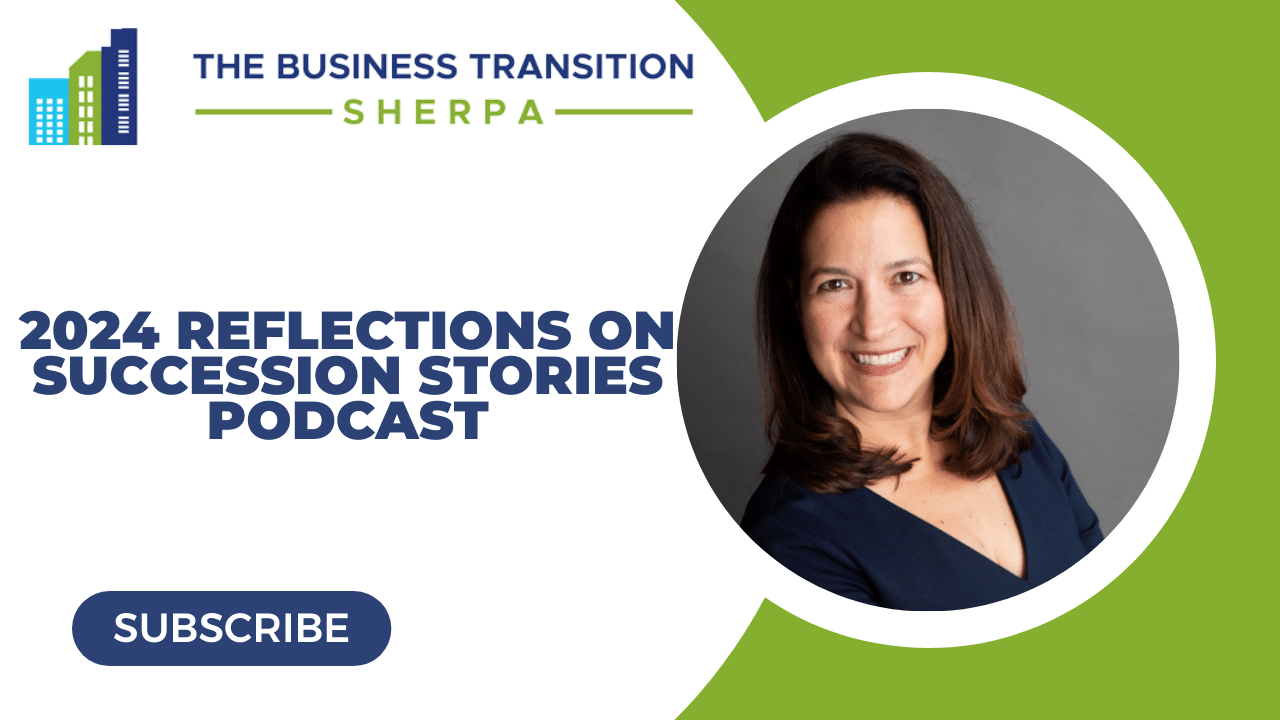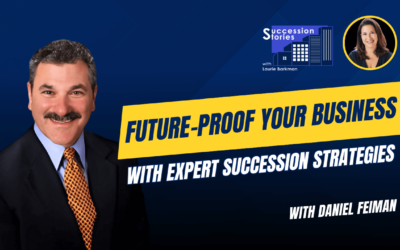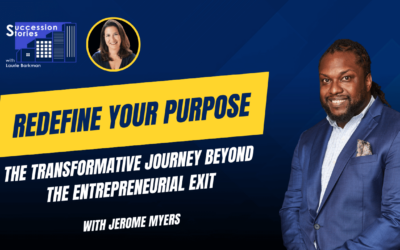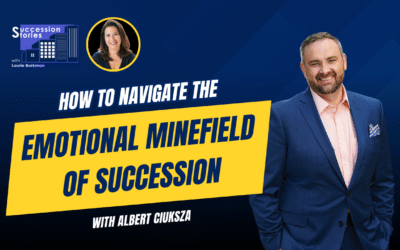Listen to the episode
I invited listeners to submit questions and a few were about CEO succession. To explore this topic, I invited Bruce Walton, a Partner at Battalia Winston, one of the world’s largest woman-owned executive search firms, onto the show. Bruce is an expert at recruiting CEOs, C-Level executives, and private company Boards.
We talked about Five Best Practices for recruiting external executives, competencies in a post-COVID world, and hiring up for the long term.
Whether you are a Founder, Owner, Board Member, or an incoming CEO, it’s about fostering respect, rapport, and stewardship. Succession takes time to get right, and a hurried plan may be destined to fail.
Listen to learn more about:
- Succession planning in a post-COVID world
- Best practices for for succession planning and recruiting external executives including:
- Culture, Competency, Communication, Long Term Incentive Plans, and Mindset
- Creating an independent Board of Directors or Advisory Board to drive accountability
- How EQ and stewardship encompasses being a successful external CEO
Show Links
Connect with the host, Laurie Barkman on SmallDotBig.com and sign-up for an insights newsletter to build value in your company.
Subscribe to the podcast
Subscribe wherever you listen, Apple Podcasts, Google Podcasts, Spotify, Stitcher, and more.
If you enjoy the episode, please give a 5-star rating and review to help others find the content. Here’s a quick how-to guide for Apple Podcasts/iTunes online.
Episode transcript
Laurie Barkman:
Welcome to Succession Stories, insights for next generation entrepreneurs. I’m Laurie Barkman. I’ve spent my career bringing an entrepreneurial approach to mature companies struggling with change as an outside executive of a third generation, 120 year old company, I was part of a long-term succession plan.
Now I work with entrepreneurs, privately held companies, and family businesses to develop innovations that create enterprise value and transition plans to achieve their long-term goals. On this podcast, listen in as I talk with entrepreneurs who are driving innovation and culture change. I speak with owners who successfully transitioned their company and others who experienced disappointment along the way.
Guests also include experts in multi-generational businesses and entrepreneurship. If you are a next generation entrepreneur looking for inspiration to grow and thrive, or an owner who can’t figure out the best way to transition their closely held company, this podcast is for you.
Subscribe to our newsletter for more resources to build value in your business and plan your transition. Visit SmallDotBig.com and sign up today.
A few months ago, I invited listeners to submit questions and a few were about CEO succession. To explore this topic, I invited Bruce Walton onto the show. Bruce is a Partner at Battalia Winston, one of the world’s largest woman-owned executive search firms, and an expert at recruiting CEOs, C-Suite, and private company Boards. We talked about Five Best Practices for recruiting external executives, competencies in a post-COVID world, and hiring up for the long term. Whether you are a Founder, Owner, Board Member, or an incoming CEO, it’s about fostering respect, rapport, and stewardship. Succession takes time to get right, and a hurried plan may be destined to fail.
Laurie Barkman:
Bruce, thanks so much for joining me today. I am excited to talk to you about a topic that is on the minds of many owners and next generation leaders alike, be they family or professional outside CEOs. And the topic is Letting Go. Will a CEO let go? When is it time to go? It’s such a critical topic for succession. The very first episode of this podcast, I don’t know if you know this, I talked with an outside CEO about that. That was also my work experience. You have so many amazing years of experience working with family-owned businesses, to recruit C-level executives and CEOs for those companies. I’m super excited that you’re here today, because I know that you’ve seen it all. So welcome.
Bruce Walton:
Thank you. Nice to be here.
Laurie Barkman:
So why don’t we start by you telling us about Battalia Winston, the firm that you’re a part of, the family-owned practice that you help lead, and your experience?
Bruce Walton:
Sure. Battalia Winston is headquartered in New York. We’re about a 60 year old firm. We’re female owned, which makes us somewhat unique. We’re a mid-sized firm with multiple specialties. We have a very strong Life Sciences Practice. Probably the biggest practice in the firm is the Industrial Practice, and the Family-Owned Business Practice is headed by a colleague out in the Chicago area and me. We focus our attention – it’s probably over half of my personal business – on multi-generational family companies, primarily at the CEO level, but also at the direct report to the CEO level.
Laurie Barkman:
Wonderful. For you and your experience you’ve been working in this field for how long?
Bruce Walton:
About 35 years. The quick history on me – out of college I was in in the Navy for a couple years as an officer and then came back to work for Ted Hood, a sailmaker up in Marblehead Mass., and then went back to business school at Harvard and joined IBM. I spent seven years with banks and insurance companies selling for IBM. And then I got recruited into the recruiting business at one of the bigs, Russell Reynolds. Then I went to Heidrick and Struggles which was another big. We went public. And then the bust of 2001 happened, and I joined a startup. And now for over 10 years I’ve been with Battalia Winston.
Laurie Barkman:
Okay, and you’re in Boston. I don’t know if you mentioned that you’re in Boston. Beautiful Boston.
Laurie Barkman:
So, question for you around multi-generational companies and the trends that you see in searching for new leadership. I think there was a trend, an upward trend for a lot of years. Are you still seeing that trend, especially now?
Bruce Walton:
We’ve definitely seen the trend, but COVID has thrown a monkey wrench in everything. It is frozen. Our business model recognizes that uncertainty tends to freeze our clients. If they don’t know which way the wind is going to fill-in, they stay at anchor, and COVID has had that effect on the business today. A number of searches have completed. And the change with COVID has been that you have to redefine what your needs are going to be over the next two or three years, because the best candidate pre-COVID may not be the best candidate post-COVID. And that’s turned a couple of searches into different directions, we’ve experienced.
Laurie Barkman:
Well, that’s a really great point. What are some of the key differences that you’re seeing in terms of what companies are looking for now?
Bruce Walton:
I think it’s the ability to turn on a dime, put together an interim plan and measure it very quickly, and then stay sensitive to whether it’s working. You can’t set a five-year plan and stick to it. I know at the beginning of the COVID pandemic, there was a Harvard Business School series of Zoom seminars on how to react to it. And the big message there was that you have to stick to your core values, what’s important, and then build teams that can respond quickly and recognize that the answer now may not be the answer in a month. But you don’t have the same certainty surrounding your environment. You have to react quickly. And the core to doing that without getting in trouble is to make sure everybody’s paying attention to the core values, which frankly is very similar to the key driver in family owned businesses.
Laurie Barkman:
Core values. I think that’s an awesome place to start with these companies. Because I have asked the question of different guests that have come on, “How have your core values helped you make decisions during this time?”
Bruce Walton:
It absolutely is. Multi-generational families tend to have spent time defining them and putting them into some sort of document either, on their website or internally. Entrepreneurial folks frequently haven’t taken the time yet to do that. But particularly in the kind of uncertainty we’re dealing with now, where people are working from home, there are a whole lot of different changes. Those fundamentals are important to spend time thinking about and codifying.
Laurie Barkman:
Yeah, definitely. So let’s talk about transitioning to a non-family CEO. Certainly you have a lot of experience with this in working with the companies that are looking for that right person to come in. What’s the process look like? And what are some things that multigenerational companies – who don’t have a family member to transition to – what are some of the things to consider when they’re looking for a non-family CEO?
Bruce Walton:
Well, once you’re north of even $25 or $30 million dollars (revenue), I think the most important thing for setting the foundations for a successful search is having some kind of a board – an outside perspective, a sounding board to help ownership go forward. I’ve written a number of articles about this. And one of the keys in the smaller company range is that, if you bring in a good person from the outside, they’re going to bring ideas that may scare the pants off the owner. And the owner needs a way to reflect on those ideas and assess them. The extra perspectives that come from even an advisory board are really helpful there. The other side of that coin is that a good CEO does not want to be simply at the whim of an owner. They want to have a way to influence the owner. There is some risk management involved here for the outside CEO, protecting them from an owner’s whims. A review by a board can get things on track. Owners frequently are emotional about what they’re doing. Emotions drive a lot of decisions. I’ve been impressed over my career that way; I like to think that business decisions are made on the basis of what’s best for the company. It’s my experience, both as an IBMer and as a consultant, that at least half of a decision is based on personal motivations. So you have to have somebody to temper that. That’s the board.
Laurie Barkman:
So if a company does not have an advisory board or a fiduciary board, there’s that, I guess, open space where maybe there’s a family council that’s helping to drive some of these decisions. And maybe let’s talk about it from a couple different standpoints. A lot of listeners out there, I’m guessing, do not have an advisory board in place. Let’s say if they’re under $30 million, as you said. So if a CEO at some point is starting to think about a transition, generally, how many years out do you think they should start having this conversation with themselves or their family? Is it five years out? 10 years out?
Bruce Walton:
There’s time and there’s age. I think it takes at least two or three years for a new board to get its feet on the ground, get its processes in order and get into a cadence and a comfort zone. I think if you’re looking at retiring as a CEO, and you haven’t started making plans or thinking about it in your early 60s, it gets harder as you get older. And if you reach 70, without having pulled a trigger here, you may end up going out with your boots on, and that’s not good for the enterprise. And frankly, one of the most important jobs a board does is select a new CEO. And we’ve got lots of scar tissue from CEOs who wanted to do the process themselves. We’ve had to wrestle them back into making sure there’s a search committee that has the board involved. So it takes time and it takes energy, and you don’t just do it on the fly.
Laurie Barkman:
Yeah, a board can be extremely helpful in being independent and having a broader perspective, especially if they are independent. They’re not owners. And I’m curious, in your experience, though, when you talk with the CEO who maybe is the primary owner, and they don’t have a family successor, what’s the thought process for them in letting go. I’m sure you’ve had many conversations with people who struggle with that. What’s a typical conversation look like in the getting started phase?
Bruce Walton:
I was asked a question by a very successful Founder/Owner, who said, “What are the five most important things for a successful transition to a non-family CEO?” There were four items I’ve been talking about and writing about for years. I called a successful CEO who had been in the saddle for 10 years and then kicked up to Chairman in a search I did quite a few years ago, and he added the fifth item. There’s a combination of structures, and processes and mindset.
I think that from the structure side, you need board governance, and you need some long-term incentives, so that the new CEO has a way, clearly, a way to build personal capital and retire when they want to retire. Private family-owned companies are very reluctant to give up stock. They don’t have to do that. There are ways to do that on a cash basis in a way that makes the new CEO act and feel like an owner, but without giving up stock. So those are sort of two structural things.
I think the focus on, “Who’s going to be successful?” really comes down to Fit. There are two components to the word “Fit”, something that everybody uses as a key term. And it is, but what does it really mean? One part of it is Culture. Will the CEO embrace and become a steward for the core values of the family? That’s an important starting point, because they do become the steward of that culture. Stewardship is perhaps the single term that reflects all of the things that go into being a successful non-family CEO.
The second piece of Fit is what we call Competency. And that’s, “Can they do the job? Do they have the skills and experience?” We require that our clients go through a process where we identify the top five to seven competencies that you’d like to see displayed successfully in the recent past within the experience by the candidate as a marker that they can come do that for us.
And there are two or three documents that come out of the first part of the search. One is a Specification. It’s a job description, but it’s more of a marketing document. It describes the company, what needs to get done, the qualifications, and a little bit about compensation without revealing too much. Out of that we derive a Competency Model on the basis of, “If this is the mission and what has to get done, what competencies would you like to see displayed?” They could be things like strategic assessment, very high EQ, financial savvy, strategic hiring – those kinds of things. They’re unique to each situation. The top-level descriptions may travel from search to search, but the underpinning (verbiage) that applies to this client is unique to each situation. The competency model is absolutely core in my view, because once you identify all the important things, then you can ask, “What are the top three or four, and what are the ones where you could give up a little on?” The ‘nice to haves’ versus the ‘must haves’ really helps us go into the marketplace. We can talk a little bit about how we do that. We seek advice from people who know the fish ponds we’re fishing, we have about two minutes or less in order to focus their attention on what’s really important in this situation. And so we have to be very much on the same page with our client. The discussions about the competency model and the prioritization of it are absolutely core to getting it done right the first time.
Laurie Barkman:
Yeah, the competency model you talked about it earlier is shifting, too. You might find that some of the skills that more entrepreneurial companies have, or intrapreneurial, if folks have worked inside a big company, and created a new business or a new product line, that might be more of a fit for some companies undergoing change in the future.
Bruce Walton:
Absolutely.
Laurie Barkman:
And EQ. You brought that up. That’s come up a couple of times on other shows too. I think you do need a high degree of EQ to deal with some family dynamics. As a candidate or somebody who’s talking to the executive search firm, what types of questions do you get from them most often so that they can judge whether or not it’s a fit for them?
Bruce Walton:
I’m not sure I can give you specific questions, but they tend to revolve around how does the company work? What is the decisioning process? Who are the key voices? Is this company managed professionally? And my simple observation is that the best candidates come from well run well governed companies. And if candidates don’t see those kind of processes and structures in place, they’re going to be worried that this company will not be run as well as it could be. Now, they’re going to be asked to bring in some of that for sure. But if you start from ground zero, it’s higher risk for a quality candidate. And some of the best candidates will withdraw.
Laurie Barkman:
Do candidates ask about, in a gentle and professional way, the CEO’s desires to really, truly step back and separate from the day to day?
Bruce Walton:
They do. It’s the single most generally asked question. When I want to take on a search, I talk to people within the company. I need to understand the culture from the recruiter’s perspective. And at the CEO level, the question always is, “Will they let go? I can tell a story about about a $100 million family business that had a five person outside board. It had a Family Council. It was very well consulted-to by leaders in the family business consulting arena. But they had a youngest of three brothers who ran the company, each in turn, who had a real control, psychological issue, if you will, and we talked about it. We set up things, like a search committee where there was an outside board member as co-head of the search committee. Once the candidate was appointed, we made sure that there was an outside lead director to who could talk on behalf of the outside directors. But interestingly, there was so much concern from the way this CEO had operated that the Family Council, in conjunction with the board, set up tripwires saying, “If you don’t step back and let the new guy do their job and you keep fiddling with things and getting down into management, those tripwires could result in you being thrown off the board.” And guess what? Within a year and a half, he was thrown off the board.
Laurie Barkman:
And he had bought in ahead of time to those tripwires. He knew exactly what they were.
Bruce Walton:
Yeah. Well, I wasn’t privy to all those conversations. But the board made it pretty clear to him that, “Hey, you have to step back.”
Laurie Barkman:
Yeah.
Bruce Walton:
And there are symbolic things that you can do.
Laurie Barkman:
What are some examples of that?
Bruce Walton:
Well, they moved his office out of the corporate headquarters. There were articles in the internal company magazine that was published quarterly that talked about those transitions. They held his feet to the fire. There were some transitions points where the new CEO took on more and more responsibility over a four to six month period, so that he didn’t get overwhelmed at the beginning. And those things were committed to, and the board made sure that they happened, if you will.
Laurie Barkman:
Yeah. And again, in this example, there’s a board, which really is so helpful to not only setting up the tripwires but holding the CEO accountable to their actions. I have some listeners that have submitted questions around situations where they are outside hire CEOs, and there is no board in place. Crossing the border on a day to day basis is more acute than they would have expected. And so I did want to talk to you about that. Because again, from a listener standpoint, I did get some questions on this. And it seems to be that the handoff, the Founder or Owner transition to the outside CEO, is really the key. And so certainly building trust and rapport is part of that is going through the process and getting on-boarded. But then over time, how should the current Founder CEO who’s transitioned out, be thinking about truly letting go? And then for the new CEO to have the appreciation that that person might want to stay relevant, but not cross that line in going from oversight or governance, if you will, to management?
Bruce Walton:
To answer that, I’m going to go back to the earlier question you asked where I gave you only four answers: Culture, Competency, Board Governance, and LTIP. Mindset was the fifth. And to get at that, I called a CEO I had placed as COO 12 years prior, and asked why it worked. This was a bigger company, a NYSE company that had about $600 million revenues. He said, “It’s about respect and rapport. The outgoing Chairman needs to respect that the new CEO will come with a different toolkit. And, of course, they have to like each other – the rapport has to be there. But they have to keep that in mind, because there are going to come times when the new guy is going to do things differently. And that’s going to create some tension. But having the mindset of respect and rapport can keep it from from blowing up. And it’s not easy at times.”
Laurie Barkman:
Yeah, and it just probably takes time to build that respect and rapport, and I suppose the trust, especially if someone’s name is on the door. They’ve hired this person, and they have the trust in their capabilities, but at the same time, they’re just not quite ready to let go.
Bruce Walton:
If you look, five years ahead, hopefully, the company is going to be larger than it is today. “A” players aren’t going to sign into a job that’s just going to keep the company where it is. So you’re really hiring somebody to do a job bigger than the one you have, today. And that may be a hard concept to get your head around as a CEO, but you really should be looking “up” at the new CEO candidates, not down. If you’re looking down at them, that means they’re already smaller than you. And it’s a higher risk that they’re not going to be the person to take the company to the next level and grow it. So I think it’s important, and it comes along with respect and rapport, that the mindset be one of thinking five years ahead, “What are we going to need then? And and how are we going to get there?” And that usually means hiring somebody who’s more senior, perhaps, than you had imagined. So you’re looking at least across, and probably up, to the candidates. That make sense?
Laurie Barkman:
Yeah, it does. It does. I want to go back to aligning interests on the financial side, because you’re right, if the goal is to grow the company, and in five years, we’re all going to be benefiting. You mentioned that equity is not always part of the compensation package for an outside CEO. And there are other ways to align interests for long term incentive plans on a cash basis, etc. I was wondering if you could dive a little bit deeper on that?
Bruce Walton:
Well, there are cash approaches. The first thing I would say is, and I’ve had people tell me that they wanted to do it themselves, is to set up a long term incentive program (LTIP). My advice to them is to hire a professional compensation consultant who is used to dealing with private, smaller companies. I’ve collaborated with one here in Boston on a half a dozen different projects, and it makes a huge difference. One reason is that there are so many laws, and they change on occasion, that affect what you can and should do. It might cost $15,000-$20,000 to set something up like that, but it will pay dividends, and getting that professional perspective is important. We recruiters are anecdotal; we’re in the in the deal flow, but we don’t know the details of what’s best for every specific situation. Frequently, programs are based on EBITDA or there may be annual valuations that track growth in value. You also have to create enough of an incentive pool so that the CEO can attract and retain a good team. It’s not just what the CEO will get. Usually by $75 million in revenues, a company will have an LTIP for perhaps the top three people. And by the time they’re $100 million, that’s probably about five people. So that’s something that needs professional attention.
One of the themes that the Family Firm Institute has stressed for the last number of years – and which I embrace totally – is that “it takes a village” to support a family business. Nobody has all the expertise you need. You need a good family business counselor. But you also need a compensation, legal, investment banking, etc. There’s a series of skills that need to be available to the ownership to really do the job right as you move up through the $30 to $100 million range.
Laurie Barkman:
Do you see typically that sharing equity is for certain types or categories of companies or is it all over the map?
Bruce Walton:
I think the general feeling is, “I don’t want to give up stock, so let’s find a way to create a pool of money that is set aside and has a vesting schedule. I had one client, a $70 million manufacturing company, where the chairperson wanted to hold all of the deferred compensation within the company until the candidate turned 65. Well, there was an unusual hire. They hired a 43 year old CEO. And his response was, “Wait a minute, I want to be able to take my long-term earnings out on a vesting schedule and invest them in the market and then lose them just like everybody else,” which proved he had a sense of humor, and that he was the right guy. He tripled the value of their ESOP in about two years.
Laurie Barkman:
Pretty impressive.
Bruce Walton:
Yeah.
Laurie Barkman:
The failed attempts are as important as the successful ones. Can you share any stories where the person brought in from the outside ultimately was not the right fit?
Bruce Walton:
Yes, there was one a $150 million industrial manufacturing company that had fifth generation ownership. There were over 100 cousins. Return on investment gets hard when the denominator gets that big. So they brought in someone from an industrial background. And he was excused a year later. There was an interesting dynamic during the search endgame, because they were trying to set up his compensation program with so objectives and metrics before he was under the tent and knew whether anything was accomplishable. He responded by saying, “I feel like they’re setting up a tax code for me, and I don’t even know what the fundamentals are.” Because they had a large cousin cohort, they were valuing the company every year anyway. And they just said, “All right, we’ll just measure value increase.” But it didn’t work out. He felt he was too independent. He didn’t really want to interact with the Board or family. Now, it was complicated a little bit by the fact that when they let him go a year later, half the Board resigned. So it’s hard to tell exactly where the problem was. But that example goes to the point that Investor Relations doesn’t go away in a family business. It’s just quite different. Owners are there for different reasons: they marry in, they inherit, they have varying levels of experience and expertise around business. It’s highly emotional. Their self-concept may be tied up in being an owner. There’s just a whole lot, and I did an article on what it takes to do IR in a family business. It’s both reactive and proactive, and it’s “communicate, communicate, communicate.” In that other company where the Chairman hit the trip wires, the outside CEO said it took three years to get the Board cadence comfortable.
Laurie Barkman:
The Board cadence after the Chairman left?
Bruce Walton:
No, actually, from when he first came in. How do we report? What are we going to change to professionalize and get everybody covered the way they need and want to be covered a lot of the education goes into it. How do we ensure that the coming generation, even if they’re not (working) in the company, will be wise owners?
Laurie Barkman:
And how do they do that? How do they educate the next generation?
Bruce Walton:
Family meetings. They may be once or twice a year, and have sessions for youngsters -getting them involved in ways that give them a feel for and pride in the business they’re in. Getting involved perhaps in philanthropy. So give them a feel for the company starting back in their early teens, not just waiting until they’re in their 20s.
Laurie Barkman:
Yeah, yeah, that makes sense. And I’ve talked to some others on this show about that. And it can be a very effective process for mentoring too, if you have folks that are in their teens, and then their 20s. And then when they’re starting in their career, whether it’s in that company, or otherwise, whatever the right time is for them to join and then grow their career in the family business. On that note, a question for you. How do you know whether it’s time for that heir apparent to rise and assume the role? How do you know whether they’re qualified or prepared? Does your firm get involved in any of those types of assessments? We talked about outside assessments, but what about inside assessments?
Bruce Walton:
We we certainly do that but I can’t say that we were asked to do that a lot. Those are usually pretty emotional and sensitive conversations. We’ve had good experience with a tool called Caliper, which is a very deep dive, psychological test. It’s online and takes maybe an hour and a half to complete. We encourage clients, and we’ve used it successfully in a number of situations. But not only do the candidates get evaluated, the top management gets evaluated, so they can look at the intersection fit, what it is. And those perspectives can be very helpful. Again, I would go back to the idea of having a Board – you don’t want to just do this alone. And frankly, most Founders or CEOs, typically of smaller businesses will have some blind spots around Junior. Maybe they’ve trained Junior to do the job that they had 20 years ago. But that’s not the job for the next decade. And and somebody needs to be able to tell them that with a clear eyed perspective.
Laurie Barkman:
There may be a lot of listeners who are in that category that do not yet have an Advisory Board. What advice do you have for those owners and CEOs that have not yet created advisory board? What do they need to do to get started? What should they think about?
Bruce Walton:
Certainly, look at what keeps you up at night? What are the things you are going to have to wrestle with over the next five years. You certainly want to have an advisory board that’s copacetic and is comfortable interacting, so friends tend to be the first place you go. But then, the competency piece has to be considered. And so I think it’s important to build a matrix of what are the things are you’re going to be facing, and do you have any expertise in those areas. I call it a whitespace analysis. You need to find people who can fill in the pieces that are going to be important and that you’re missing, for that perspective.
Laurie Barkman:
Is the whitespace because of their management team, or is the whitespace because of themselves and their skill sets?
Bruce Walton:
It could be either. I built a board a year ago for a global manufacturing company, and I talked just last week to the Chairman and CEO. They had already built a very profitable and successful company. I asked, “What was the big thing you have found with the outside board?” He said, “Well, it was a little more work for me. But what it really did was it took all my management team and made them straighten up and be more precise in the way they approach things. The board challenged them.” Is that responsive to your question?
Laurie Barkman:
Absolutely. Yeah, I think that’s a really great example. There are so many things to talk about. There’s so many different aspects, but you’ve covered a lot of ground. So last question, just curiosity about you. What’s something that you do as a daily habit that others might be curious about?
Bruce Walton:
I make lists of things to deal with. I can’t keep track of everything unless it is written down. So I’m driven by lists.
Laurie Barkman:
And what’s on your nightstand? What are you reading?
Bruce Walton:
Oh, gosh. I’ve found over time that I really love the historical novels, where you learn about a culture or a different place or time with a rollicking story. You know, whether it’s about the Aztecs or about the Visigoths, or about the Far East, you learn something, and it’s a good story. And that’s what I enjoy.
Laurie Barkman:
And if you have one piece of advice for Owners and CEOs out there to stay positive, and resilient through the next phase of what we call the “new normal,” what would it be?
Bruce Walton:
You’re not alone. And you don’t have to make all the decisions yourself. Reaching out to people whose expertise you respect, whether they’re formally or informally associated with a company. People tend to have a mentor. But here’s a concept. Think of managing your personal space with a Board of your own of mentors. Not every mentor is going to have expertise in every dimension of what’s in, you know, where you need help. So building your own network of folks who can help you with different aspects of your personal life, I think is probably good advice.
Laurie Barkman:
That is sage advice. Someone once told me that you can have a cabinet. Think of it as your kitchen cabinet. And you might have people in there that you turn to from time to time, for guidance and for ideas. For CEOs that may eventually turn into an Advisory Board. But that might be an interim step. It’s very important. So one last question for you, Bruce, before we adjourn here. Do you have any favorite quotes about leadership or entrepreneurship?
Bruce Walton:
Not specifically, I just think that for a small company or family company, the term stewardship I think needs thought and definition. It’s funny. You know, I’ve been trying to do a lot on EQ over the last few years and it’s still a fuzzy concept in the adolescent stage of development, I think, and it is related. When I wrap it all up, stewardship, however you define it, is so important. People talk in ways that either convey that or don’t. And that’s what I find is a key dimension when I’m evaluating potential candidates for family businesses.
Laurie Barkman:
You shared a lot of insights with us today. And I really, really appreciate it. If someone wants to learn more about Battalia Winston, how should they find them online?
Bruce Walton
Sure, it’s BattaliaWinston.com. A lot of what I’ve talked about today has been reduced to short 600-800 word articles. On our website, there’s an area for Research and White Papers. There are about 30 of them there, and about a third of them are about family business.
Laurie Barkman:
Wonderful. They’re great resources. I’ve read all of them, and I’ll include the links in the show notes as well. Bruce, thank you so much for being here today was great to speak with you.
Bruce Walton:
My pleasure. Thank you for having me.
Laurie Barkman:
Innovation, transition growth, easy to say but hard to do.
If you’re an entrepreneur facing these challenges, I get it.
I work with businesses from small to big for strategic planning with your team to achieve your vision.
Visit smalldotbig.com to schedule a call with me. I’d love to connect with you.
Be sure to catch the next Succession Stories episode with more insights for next generation entrepreneurs. Thanks for listening.

